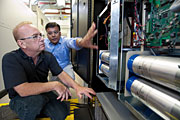- Number 345 |
- September 5, 2011
A Better Way to Connect Solar, Wind to the Grid

NREL engineers Sudipta
Chakraborty and Bill Kramer
examine the design of the power
block at a laboratory at NREL.
The large cylinders are the DC
bus capacitors. The digital
controller is on the green board.
Credit: Dennis Schroeder
The sun can shine torridly, the wind can blow viciously, but if solar and wind energy can't be converted to the 60-hertz alternating current (AC) standard in the United States, it can't be connected to the grid for use in homes or offices.
That's where the inverter fits in, a device that takes that distributed energy and turns it into grid compatible AC power.
The DOE’s National Renewable Energy Laboratory, with industrial partner Semikron, and with funding from the California Energy Commission, has developed a prototype of a 50-kilowatt inverter. Inside is a 50-kW modular power block the size of a microwave oven that can be included with a photovoltaic array, small wind turbine, battery charger, fuel cell or flywheel and control the flow of energy onto the electric grid.
When the power block is produced in volume, the price is expected to be just one-third of the cost of other integrated power electronics of the same rating.
It will be packaged inside a 6-foot by 2½-foot inverter, which also will contain inductors, capacitors, sensors, contactors, pilot relays and a DC power supply, along with protective devices to suppress surges, protect against ground faults and ensure emergency shut off.
A digital controller in the brains of the power block allows the user to modify control algorithms to allow it to work with different technologies, Ben Kroposki, leader of the Distributed Energy Systems Integration group at NREL, said. Used in an inverter, "the power block will allow utilities to let more renewable energy come online."
By combining off-the-shelf high-volume, high-quality components from Semikron, with a flexible controller and software module from NREL, the power block combines reliability, flexibility and cost savings.
"This is a building block for multiple applications," said NREL electrical research engineer Sudipta Chakraborty, the lead researcher on the project. "It doesn't matter what renewable energy application you're using, this will be the heart of the power conversion.
NREL has a Cooperative Research and Development Agreement with the California Energy Commission. CEC is using NREL's algorithms developed on the 50-kW power block as a way to help lower electric bills for California customers.
The power block is designed to use in various power converters such as DC to AC (alternating current), AC to DC, or DC to DC converters.
In the case of photovoltaic systems — those that convert the sun's photons into electrons for electricity — the power block acts as a DC to AC converter. A large photovoltaic system must convert the variable DC output — it varies because the sun's intensity varies — into reliable 60-hertz AC power that can be accepted by the grid. Once it's on the grid, any consumer or business can use it.
If the task is battery charging, the power block converts AC power from the electric grid to DC to charge the battery. Conversely, if the task is battery discharging, the power block acts as a DC
Companies that buy the power block can use the built-in controller board and NREL’s software, or swap it out and use their own controllers.
"It's in its final prototype stage," NREL's Bill Kramer, the principal investigator, said. "After one more redesign, we'll get a dozen or so of these into the hands of industry across different disciplines to get their feedback. We hope they start using these components in their designs to lower their costs." For more on the power block see the NREL feature story.
[Bill Scanlon, 303.275.4051,
william.scanlon@nrel.gov]
